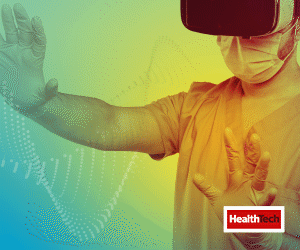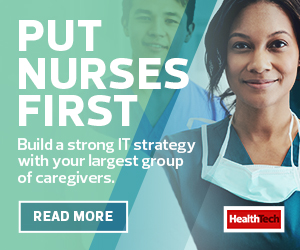Editor’s note: This content series, featured in your Insider dashboard, will be rolled out over the coming weeks to offer advice on driving collaboration between IT teams and clinical staff. (If you’re not already an Insider, sign up for free here.) The associated articles explore why nurses should be included in the decision-making process for purchasing new equipment and how to develop this relationship as part of your IT strategy.
Technology is enhancing the field of nursing in many ways by making nurses more efficient and better informed to deliver strong patient care. From handheld mobile units and wearables to software-enabled command centers, these devices and apps offer nurses critical insights that are easy to access and share with other clinicians.
“Technology can really streamline information across the continuum of care and extend the human touch of nurses,” Sue Murphy, chief experience and innovation officer at University of Chicago Medicine, tells HealthTech. “We never want technology to take over those interactions but to enhance the way we express that.”
In fact, a recent LinkedIn survey of more than 600 nurses found 82 percent believe new technology will positively impact patient care by helping improve human processes and reduce human mistakes.
Here are five areas of continued development:
1. All-in-One Mobile Devices Streamline Workflows and Save Time
A single portable tool used to communicate, obtain patient data and track patient care reduces the need to continually run back to nursing stations. With instant access to patient information, an onboard barcode scanner and the ability to receive alerts, it allows more focus to be placed on day-to-day patient care.
“Nurses can spend more time on the important things instead of looking at 17 different things,” Murphy says.
At Truman Medical Centers in Kansas City, Mo., nurses use the Zebra Technologies TC51-HC, a combination of a mobile computer, phone and barcode scanner. The devices give nurses many advantages, including the ability to send messages, receive alerts and transmit images directly to a patient’s health record or to another caregiver.
READ MORE: Learn how rugged devices offer protection from drops, shocks and spills.
2. Wearables Support Bedside Care and Remote Patient Monitoring
Wearables also offer great benefits for both nurses and their patients. Small, Wi-Fi-enabled devices such as smart watches and monitors can now track and transmit personal health data such as glucose levels, blood pressure, body position and physical activity so nurses can keep a better eye on patients — whether they’re at home or in a hospital.
Doing so can improve care, save time, prevent medical errors and minimize the potential for adverse effects. Wearables “provide numerous benefits to nurses, such as freeing up time to provide better-targeted patient care,” Lindsay Coffman, a senior clinical nurse editor for Wolters Kluwer, writes in the journal Nursing2020 Critical Care.
Wearables help patients take an active role in their care and understand, in real time, the effects of their behaviors. Likewise, automatically generated data and analysis help nursing teams intervene more quickly, according to the The Journal for Nurse Practitioners.
This has proven particularly important as healthcare teams monitor discharged COVID-19 patients for signs of trouble as they recover.
3. Telehealth Platforms Enable Secure Connections from Anywhere
Telehealth solutions allow nurses to expand their reach and care for low-acuity patients without potentially exposing anyone to COVID-19.
It’s also aiding critical cases: Many hospitals have explored tele-ICU applications during the pandemic, according to MIT Technology Review. High-definition cameras, telemetry and a multidisciplinary team of intensivists give nurses the ability to remotely monitor ICU patients, regardless of where they are.
Falls Village Skilled Nursing & Rehabilitation in Cuyahoga Falls, Ohio, has used telehealth applications to reduce rehospitalization rates, according to mHealthIntelligence. Previously, nurses had to wait on an off-duty doctor to respond when they saw a patient in decline; the new telehealth system can access a doctor in less than an hour.
“Nurses very much appreciate the fact that they have dedicated access to a physician on those off-hours,” says Falls Village administrator Nick Gulich. Additionally, “it boosts their assessment skills. They know what to look for a bit better. It has boosted their confidence.”
4. Mobile Workstations Offer More Seamless Care
While nurses have long used wheeled care cars and portable monitors, these devices are becoming smaller, smarter and more capable. These machines mobilize equipment, medicines and health records for nurses to access at the patient’s bedside.
And the new carts are lightweight, economic and more easily maneuverable, according to a 2019 case study in the Journal of Clinical Engineering.
“Already overloaded as it is, nurses seek ways to eliminate steps in the workflow, not add more. When they can deliver seamless care, interacting easily at the patient’s bedside, it enhances the hospital environment,” the case study notes.
5. Command Centers Deliver Detailed and Actionable Insights
Software-enabled command centers offer real-time updates, improve patient experiences and help nurses stay more actively aware of schedules, patient needs and room availability.
AdventHealth in Florida is using a new command center to coordinate care across departments, HealthTech reports. Custom-built dashboards help align scheduling and screenings and enable nurses to prioritize care and treat the sickest patients first.
At the University of Chicago, command centers have been instrumental in helping nurses make better decisions about patient care.
“All the information is in one location so we can make decisions without having to go many different places,” Murphy says. “We use that for staffing, scheduling, discharge, plan of care and post-acute care.”













